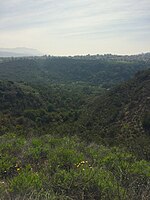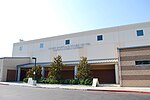Wildwood Regional Park

Wildwood Regional Park is a suburban regional park in the western Simi Hills and Conejo Valley, in Ventura County, California. It is located in western Thousand Oaks, northern Newbury Park, and southern Moorpark. Wildwood is home to over 27 miles of hiking trails. The four principle trails are the Mesa-, Moonridge-, Wildwood Canyon- and Santa Rosa Trails. Over 250 plant species have been recorded in Wildwood, as well as 37 species of mammals, 70 bird species, and 22 species of amphibians and reptiles.The park consists of 1,765 acres (7.14 km2), and is connected to adjacent open-space areas comprising an additional 1,400 acres (5.7 km2). The park is operated by the Conejo Open Space Conservation Agency (COSCA).
Excerpt from the Wikipedia article Wildwood Regional Park (License: CC BY-SA 3.0, Authors, Images).Wildwood Regional Park
Brittany Park Road,
Geographical coordinates (GPS) Address External links Nearby Places Show on map
Geographical coordinates (GPS)
| Latitude | Longitude |
|---|---|
| N 34.220833333333 ° | E -118.91111111111 ° |
Address
Wildwood Park
Brittany Park Road
91320
California, United States
Open on Google Maps








